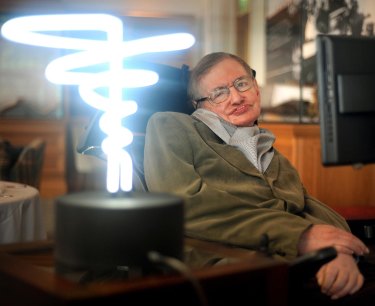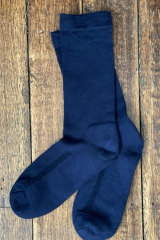Stephen Hawkings thoughts on the big mystery of missing socks
No lesser person than the theoretical physicist Stephen Hawking once put his mind to the mystery of the missing sock. Like many others he wondered where they ended up. His conclusion, as explained in a book called The Nature of Space and Time, is that spontaneous black holes are responsible for their disappearance.
Hawking’s conclusion may be tongue-in-cheek, but his curiosity is hardly surprising. The sock thing really is enormously annoying.

Professor Stephen Hawking poses beside a lamp titled ‘Black Hole Light’ at the Science Museum in London in 2012. Credit:PHILIP TOSCANO
After all, most of us have two feet. We remove our socks (count them: two); we throw them both into the washing machine (another count: still two); then, after various forms of drying, we sort the washing and start placing the pairs together.
At which point, in every single washing, at least one sock has lost its pair. Stranger still, the sock that has lost its pair is always your favourite sock.
I don’t mean to compete with Stephen Hawking when it comes to scientific rules, but the scratchy, nylon, tartan thing somehow never loses its pair.
To prove my theory, I’m willing to show you the awful, much-hated pair I acquired three decades ago. I am wearing them now.
Anyway, over time, the more lovely socks, the widowed socks, accumulate in great mountains, forcing every sock-owning human to make a choice.
They are choices that reveal much about ourselves.
There’s one personality type â€" let’s call them the Ruthless Rationalists â€" who give each sock two weeks in which to be reunited with its twin. If not: out it goes.
Can we pause a moment to understand what that means. It means being thrown into a bin, alongside the dirty nappies and the fat we cut off lamb chops because we imagine we are on some sort of diet. We serve up this indignity to the poor single sock for no better reason than that it is no longer a member of some sort of cosy pair.
Talk about insensitivity. Talk about prejudice.
We treat single socks, in other words, in the same way that travel companies treat single people. Complete contempt. If you are not part of a cosy couple, you’ll have to pay extra.
Then again, consider the alternative. The other personality type could be called the Foolish Optimist. This is the person whose glass is always half-full. This description also suits their ironing basket. Half-full? It’s three-quarters full. Entirely of orphaned socks.
Every week’s ironing and sorting begins with this moment of defeat. Oh, that’s right. I’m the owner of 57 single socks, socks which I’ve never quite had the agency, or the get-up-and-go, or the pure vicious bloody-mindedness to deal with.

Socks, once happily paired, always seem to disappear in the Glover household.
“I’m a failure in lifeâ€, that’s what you mutter to yourself as you fight through the single socks in the attempt to retrieve a shirt. “I need to find a way to say farewell to this detritus of my past, and thus be reborn,†you mutter. “If only I could do it with the socks, I could then do it with my awful siblings, my boss at work and those bastards I met at the school reunion.â€
All this goes through the mind of the hoarder of the single sock. And yet, in socks as in life, hope is often the wisest course.
Next week, you might pull forward the dryer and find five singletons huddled there, next to the wall, just waiting to be reunited. What bliss that you will be able to put them together, at last reuniting them with their long-lost partners.
The more organised of these hopeless optimists tie the widowed socks together, creating a flailing figure called “The Socktopussyâ€. This way, they believe, the solo socks will not mingle with those that are still in pairs, perhaps poisoning them with their influence.
“Look at me, look at me, I’m no longer in a pair. You should try it. It’s great. Best of all, I don’t have to be pulled onto his fat feet, thence to spend the day being, well, downtrodden.â€
Of course, if Hawking is correct, even “The Socktopussy†represents pointless hope. Once a sock has been sucked into a black hole, there is no coming back.
The only realistic sock policy may be that advocated by the American consumer advocate Ralph Nader. In 1959, he famously purchased four dozen pairs of identical black socks, so that â€" for decades to come â€" each fresh singleton could find a partner in another who had just lost its pair.
And yet the Nader solution does not mean we can rest easy when it comes to life’s mysteries. Other conundrums beckon, just waiting for the consideration of a future Stephen Hawking.
Why, when driving on a country road, is there often a single boot lying by the roadside? Has a one-legged man just bought a new pair of footwear and decided to rid himself of the unwanted boot by the throwing it out the window? Is it an ancient rural system for claiming possession of the long paddock?
And why are there always crumbs in the bottom of the cutlery drawer, even in households in which they never make toast?
Maybe the solo roadside boot is, in the end, sucked into a black hole, displacing some unwanted socks, which return to earth in the form of crumbs.
If only Hawking was still around to do the numbers.
In need of some good news? The Greater Good newsletter delivers stories to your inbox to brighten your outlook. Sign up here.
0 Response to "Stephen Hawkings thoughts on the big mystery of missing socks"
Post a Comment